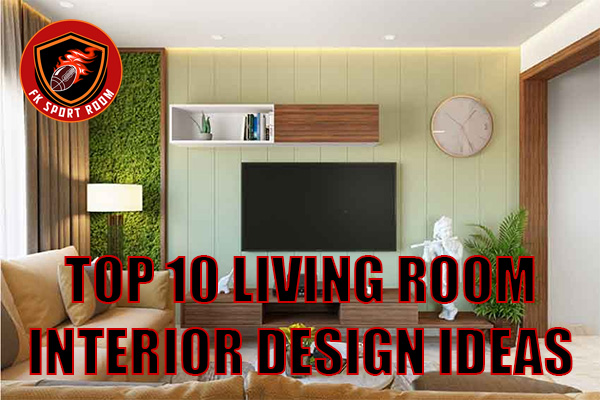Blogs
Top 10 Living Room Interior Design Ideas to Transform Your Space
Designing your living room is one of the most rewarding parts of decorating your home. As the heart of the house, it’s where family gathers, friends connect, and relaxation happens. Whether you prefer cozy and warm or sleek and modern, the right interior design can completely transform your living space.
In this guide, we’ll explore the top 10 living room interior design ideas with practical styling tips, pros and cons, and inspiration to help you create a living room you’ll love.

1. Modern Minimalist Living Room
A minimalist living room is all about clean lines, neutral tones, and functional furniture.
How to style it:
- Choose a neutral paint color like white, beige, or soft gray.
- Add sleek furniture with straight edges and slim profiles.
- Use rugs with subtle textures (wool or jute) for warmth.
- Incorporate natural light and keep accessories minimal.
Pros:
- Easy to maintain.
- Creates a calming, clutter-free space.
Cons:
- Can feel cold if not styled with soft textures.
- Limited opportunity for bold personality.
2. Scandinavian-Inspired Living Room
Scandinavian design is known for its cozy simplicity, functional pieces, and emphasis on natural light.
How to style it:
- Paint walls in light colors: white, pale gray, or muted pastels.
- Choose wooden furniture with simple designs.
- Add hygge elements like knitted throws, layered rugs, and soft lighting.
- Use floor lamps or pendant lights to enhance warmth.
Pros:
- Perfect for small spaces.
- Bright, airy, and timeless.
Cons:
- Neutral palette may lack bold character.
- Can look too “bare” if not layered properly.
3. Bohemian Living Room
Boho interiors celebrate creativity with bold colors, patterns, and eclectic accessories.
How to style it:
- Paint with earthy tones (terracotta, mustard, olive green) or jewel shades.
- Mix patterned rugs, layered textiles, and wicker furniture.
- Add string lights, lanterns, or floor lamps for mood lighting.
- Decorate with plants, art, and travel souvenirs.
Pros:
- Unique and full of personality.
- Great for mixing old and new pieces.
Cons:
- Can look cluttered if overdone.
- May feel overwhelming in small rooms.
4. Industrial Style Living Room
Inspired by loft apartments, industrial design embraces raw textures and exposed finishes.
How to style it:
- Use darker paint colors: charcoal gray, deep blue, or brick red.
- Incorporate leather sofas, metal accents, and reclaimed wood.
- Add an oversized rug in neutral tones to soften the space.
- Use pendant lights or Edison bulbs for character.
Pros:
- Bold and stylish.
- Durable furniture materials.
Cons:
- Can feel cold without soft furnishings.
- Dark palette may shrink smaller rooms.
5. Mid-Century Modern Living Room
Mid-century modern design combines retro charm with timeless elegance.
How to style it:
- Choose warm paint colors: cream, mustard, or muted green.
- Pick furniture with tapered legs and clean silhouettes.
- Layer geometric rugs for a retro vibe.
- Use statement lighting like arc floor lamps or globe pendants.
Pros:
- Timeless style that works in any space.
- Combines comfort with elegance.
Cons:
- Authentic mid-century pieces can be expensive.
- Limited palette may feel restrictive.
6. Coastal Living Room
Coastal interiors bring the breezy, relaxed feeling of the seaside indoors.
How to style it:
- Paint walls in crisp white, light blue, or sandy beige.
- Add slipcovered sofas, rattan chairs, and linen cushions.
- Use striped or woven rugs to echo beachside charm.
- Layer with natural light and sheer curtains.
Pros:
- Relaxing and inviting.
- Brightens dark spaces.
Cons:
- Can look “themed” if overdone.
- White fabrics may be harder to maintain.
7. Traditional Living Room
Classic and elegant, a traditional living room never goes out of style.
How to style it:
- Use soft neutrals or rich tones like burgundy, navy, or forest green.
- Incorporate tufted sofas, wingback chairs, and ornate coffee tables.
- Add Persian rugs or classic patterned carpets.
- Use chandeliers or wall sconces for refined lighting.
Pros:
- Timeless appeal.
- Works well in larger spaces.
Cons:
- Can feel too formal for casual living.
- May require more investment in quality furniture.
8. Contemporary Living Room
Contemporary interiors are dynamic, focusing on current trends and sleek finishes.
How to style it:
- Paint in bold accent colors (navy, black, emerald) with neutral balance.
- Choose modular sofas, glass coffee tables, and metallic accents.
- Use abstract rugs and statement lighting fixtures.
- Add mirrors to enhance space and light.
Pros:
- Modern and stylish.
- Flexible to incorporate new trends.
Cons:
- Can become dated as trends shift.
- May lack warmth if overly minimal.
9. Rustic Farmhouse Living Room
Rustic farmhouse interiors combine coziness with countryside charm.
How to style it:
- Paint with warm neutrals: cream, beige, or soft taupe.
- Choose distressed wood furniture and oversized sofas.
- Add layered rugs like jute under patterned textiles.
- Use lantern-style lighting or vintage chandeliers.
Pros:
- Warm and inviting atmosphere.
- Perfect for family-friendly living.
Cons:
- Can look “country” if not balanced.
- Requires upkeep to prevent looking worn-out.
10. Eclectic Living Room
Eclectic interiors celebrate freedom by mixing styles, textures, and eras.
How to style it:
- Experiment with bold paint colors or statement walls.
- Mix modern and vintage furniture pieces.
- Layer rugs in different patterns and textures.
- Play with varied lighting fixtures for depth.
Pros:
- Highly personal and creative.
- Endless opportunities for expression.
Cons:
- Can feel chaotic without a unifying theme.
- Harder to achieve balance.
FAQs About Living Room Interior Design
1. What is the most relaxing color for a living room?
Soft neutrals like beige, light gray, and pale blue are the most calming choices, as they create a serene and airy feel.
2. How can I make a small living room look bigger?
Use light paint colors, mirrors to reflect light, multi-functional furniture, and keep clutter minimal.
3. What type of rug is best for a living room?
Choose a rug that anchors your seating area—wool or jute for texture, patterned for character, or neutral for versatility.
4. How do I choose the right lighting for my living room?
Layer lighting: combine ceiling lights, floor lamps, and accent lighting to create both functionality and ambiance.
Conclusion
Your living room is the soul of your home, and the right interior design can make it both functional and beautiful. From minimalist calm to bohemian flair, these top 10 living room interior design ideas offer inspiration for every taste and lifestyle.
The key is to balance style with comfort—choosing paint colors, furniture, lighting, and rugs that not only look amazing but also make you feel at home.
